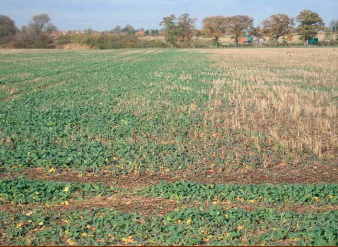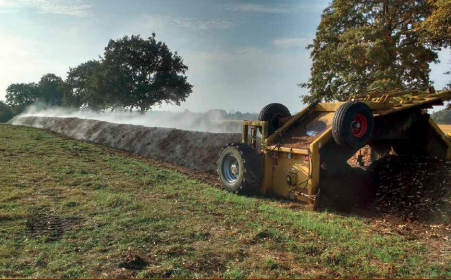
I have been farming using zero-till and biological methods for fifteen years and making my own compost has always been an integral part of the system. There are lots of biological inoculants on the market but if your soil is not in a good enough condition to live and multiply, they will soon die out. On the other hand, if your soil is in the right condition, the desired microbes will most likely be there anyway.
What is unique to compost is that it is a way of applying the good biology in it’s own, perfect environment. This means that even if the soil conditions are hostile, the good biology has somewhere to live while gradually reaching out and changing the soil from a safe base.
About twenty years ago there was a general dumping area on the farm where we used to tip odd loads of horse manure, wet bales, tree cuttings and anything that wasn’t suitable to go on a bonfire but was what we now think of as compostable. Every year or so we would go and push it up with a loader bucket just to tidy up. We didn’t have a muck spreader and there wasn’t enough there to justify getting a contractor in, so it just gradually built up over about six or seven years.

In 2013 I started applying gypsum to my high magnesium soils for which my contractor used a spinning disc muck spreader. When he finished, I asked him to get rid of the old muck heap onto the heaviest part of a neighbouring field; it covered about a third of the area at roughly 6 tons/acre. The following wheat crop grew much stronger on the compost applied area and ended up yielding at least a ton to the acre more than the rest of the field.
The next crop of rape established far better in this area and grew with more vigour, going on to yield twice as much as the rest. And so, my interest in compost had begun, and I’ve been trying to replicate that amazing result ever since. Digging down, it was obvious that a massive change had taken place, the soil was a much darker colour and the structure was aggregated and open, allowing water to pass freely down to the drains. Just walking across the field, it was easy to tell where the dividing line was by the change in wetness and stickiness under foot. (Photo of rape crop) What is even more amazing is that the line still shows up in the field to this day, in spite of me of the whole field have two more compost applications since the original. (Photo of barley 12 years later)

After doing some reading up on the effects of compost, I found out that soil aggregation is created by the life in the soil, gluing particles together and leaving pore spaces between, where water and air can pass freely up and down the soil profile. The more aggregation you have, the more the air in the soil can be refreshed, and so this enhanced oxygen availability stimulates the aerobic soil life to grow and reproduce at an ever increasing rate.
Because of the relatively low application rate of compost, I soon realised that this was not a fertilisation effect but was actually a biological inoculation. I now treat compost making as a breeding operation; the original ingredients are the food which should have a carbon to nitrogen ratio equivalent to the microbes that are going to eat it, roughly 30:1, and with as many different ingredients as possible to bring a wide variety of bacteria, fungi and all soil life.
After turning manure from our own stables with a loader, which was very slow, I was lucky to find a second hand, tractor driven windrow turner for sale at a knock down price and was then able to start composting on a bigger scale. The only livestock in this area in any quantity are horses, so they are my only option as a supply of manure. There are two riding school/livery yards nearby that need to get rid of their waste and they pay a contractor to deliver it into me.
I get the trailers to tip in a straight line in the field where the compost will eventually be spread, away from ditches and drains. The line, or windrow as it is called, then needs tidying up with a loader to get it within the four meter width of the turner. Four metres is the optimum width for a turner; a wider windrow would be to big because the centre is too far from the outside and soon becomes anaerobic, and anything narrower ends up having to be miles long to contain a decent tonnage.

It is a bit of a lottery what the ingredients are from these stables, s o m e t i m e s there is a lot of wood shavings which makes it a bit high for carbon and also too dry, but I just have to cope with how ever it comes. When there is not enough moisture for the microbes to get working, I leave it over winter and then start it again in the Spring. Manure from horses bedded on straw is the best because it always seems to hold enough urine for moisture and has the right C:N ratio. When composting manure from our own stables I have more control over the ingredients and so can make it much better and biologically diverse. Local tree surgeons drop off wood chippings occasionally, a landscape maintenance company drops grass cuttings, and then there are plenty of leaves in the Autumn.
I have used gypsum on my heavy, high magnesium soils for twenty years now, but I am not sure how good it is for the soil biology, so more recently I have been adding it to the mix at the start so that it is incorporated into the compost and is applied in a biological form. Inoculation can come from a sprinkling of previously made compost, but the last batch I made had some top soil mixed in. Quite a lot of experts recommend a clay addition to give the finished product more body and give the nutrients something to hold onto, but I think the top soil is even better. It is the ultimate biological starter because it comes from a completely natural grassing marsh which grows plentiful grass without any artificial inputs; just what I want my arable fields to do.
When finished, it had the same smell as the best, the most natural soil you could ever come across, proving that the grassland biology had been multiplied by the hot aerobic process. From the first turn to being finished usually takes four or five weeks. The idea is to not let the temperature go above 70 degrees C because the useful soil life that we are trying to multiply can’t live above that. This means checking the temperature every day and turning whenever it gets to 65. The first turn breaks up everything and thoroughly mixes the carbon and nitrogen components together, causing the decomposing bacteria to go crazy, which means that if the moisture and C:N ratio are right, 70C can be reached after one day. In practice I often have to turn every day for four days, then leave a one day gap, then three days, then turn once a week until it stops heating and the temperature stabilises.
The turner is quite aggressive, which it has to be to shred all the ingredients and get a thorough mix, but this does not help fungi and larger soil life to grow and multiply, so to get the maximum diversity, it needs to be left to mature for as long as possible, preferably up to a year. The usual application rate is about four tons to the acre, which I see as just a biological inoculation. This rate is not enough to build organic matter levels, nor are there much in the way of nutrients in that amount. I can never make enough compost, so it is about getting it to cover as large an area as possible, hoping to get around the farm every four years.
This year I have tried a field at two and a half tons, which is not easy with a big ten ton spreader, but now that my no-till land is billiard table flat, my contractor doesn’t mind driving at fifteen or twenty miles per hour. Having spent the last fifteen years making and trying to perfect the art of aerobic composting, my conclusion is that there are two things that determine the quality and effectiveness of the final product: diversity and maturity. Diversity means the biggest range of different species of bacteria, fungi etc. at the start, and maturity means how long the compost has been left so that the larger arthropods, protozoa and nematodes can develop and multiply has been left so that the larger arthropods, protozoa and nematodes can develop and multiply.